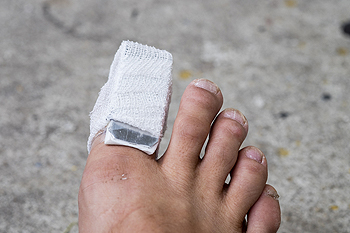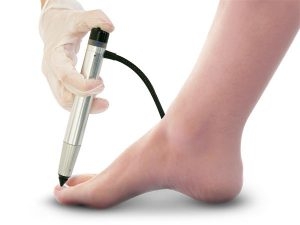Items filtered by date: April 2018
Clearanail Treats Toenail Fungus
Advanced Care Foot and Ankle is happy to offer cutting edge technology in the battle against nail fungus. Introducing Clearanail, the advanced micro drilling system for the treatment of onychomycosis. Utilizing Clearanail’s patented technology, we are able to drill precise 0.4mm holes into the infected nail plate, allowing access to the diseased nail bed.
For decades, people have struggled to treat nail fungus. Topical medications have been shown to inadequately penetrate the nail plate, leading to poor outcomes. Even newer topical medications are brand name drugs with little insurance coverage and high out of pocket costs. Oral medications have been one of the more effective treatments, but have to be taken for prolonged periods of time, increasing the chance of potential side effects. Also, some patients are not candidates for oral therapy, due to their past medical history and interactions with their current medications. Lastly, there is the method of using a nail laser, a very expensive treatment option with little success rate.
The medical field has known for years that the majority of infections of the skin and/or nail are caused by dermatophytes, relatively easy organisms to kill. We know this because when patients suffer from “Athlete’s foot,” a fungal infection of the skin, the dermatophytes are easily killed with topical medication. When the dermatophytes get under the nail, however, topical medications struggle to penetrate down into the underlying nail bed where the organisms reside. This is where Clearanail microdrilling technology comes into play. In less than 20 minutes, multiple micro pathways are created in the nail plate without pain or discomfort. This is done with a special fail-safe sensor on the drill that detects when the nail plate is penetrated and shuts off automatically.
After the creation of the pathways, patients then apply a low-cost topical medication regularly to the nail, which easily absorbs through the nail plate to kill the fungus. Patient are seeing results within 2-8 weeks from the start of treatment. Come in today to try this new advanced treatment option for nail fungus at any of our office locations!
I’ve Fallen and Injured My Toe – Have I Broken It?
If you’ve broken your toe, the chances are favorable that your toe endured trauma, generally due to a heavy object falling on it or possibly stubbing it and causing it to jam. The two toes that most often experience a fracture are the pinky and the big toe. This seldom occurs in the other toes because they are protected by the toes next to them. One of the first signs of a broken toe may include pain and swelling, in addition to possible bruising in the affected toe and surrounding area. If the bone appears to be protruding, often occurring after a harsh fall, an X-ray may be necessary to determine the severity of the fracture. Treatment may consist of taping the toe to the one next to it or utilizing a splint for the affected toe. It’s suggested to consult with a podiatrist to learn more about symptoms and treatment options for a broken toe.
A broken toe can be very painful and lead to complications if not properly fixed. If you have any concerns about your feet, contact Dr. Kenneth Donovan from Advanced Care Foot and Ankle. Our doctor will treat your foot and ankle needs.
What to Know About a Broken Toe
Although most people try to avoid foot trauma such as banging, stubbing, or dropping heavy objects on their feet, the unfortunate fact is that it is a common occurrence. Given the fact that toes are positioned in front of the feet, they typically sustain the brunt of such trauma. When trauma occurs to a toe, the result can be a painful break (fracture).
Symptoms of a Broken Toe
- Throbbing pain
- Swelling
- Bruising on the skin and toenail
- The inability to move the toe
- Toe appears crooked or disfigured
- Tingling or numbness in the toe
Generally, it is best to stay off of the injured toe with the affected foot elevated.
Severe toe fractures may be treated with a splint, cast, and in some cases, minor surgery. Due to its position and the pressure it endures with daily activity, future complications can occur if the big toe is not properly treated.
If you have any questions please feel free to contact one of our offices located in Warren, Livingston, and Toms River, NJ. We offer the newest diagnostic and treatment technologies for all your foot and ankle needs.
I’ve Fallen and Injured My Toe - Have I Broken It?
 If you’ve broken your toe, the chances are favorable that your toe endured trauma, generally due to a heavy object falling on it or possibly stubbing it and causing it to jam. The two toes that most often experience a fracture are the pinky and the big toe. This seldom occurs in the other toes because they are protected by the toes next to them. One of the first signs of a broken toe may include pain and swelling, in addition to possible bruising in the affected toe and surrounding area. If the bone appears to be protruding, often occurring after a harsh fall, an X-ray may be necessary to determine the severity of the fracture. Treatment may consist of taping the toe to the one next to it or utilizing a splint for the affected toe. It’s suggested to consult with a podiatrist to learn more about symptoms and treatment options for a broken toe.
If you’ve broken your toe, the chances are favorable that your toe endured trauma, generally due to a heavy object falling on it or possibly stubbing it and causing it to jam. The two toes that most often experience a fracture are the pinky and the big toe. This seldom occurs in the other toes because they are protected by the toes next to them. One of the first signs of a broken toe may include pain and swelling, in addition to possible bruising in the affected toe and surrounding area. If the bone appears to be protruding, often occurring after a harsh fall, an X-ray may be necessary to determine the severity of the fracture. Treatment may consist of taping the toe to the one next to it or utilizing a splint for the affected toe. It’s suggested to consult with a podiatrist to learn more about symptoms and treatment options for a broken toe.
A broken toe can be very painful and lead to complications if not properly fixed. If you have any concerns about your feet, contact Dr. Kenneth Donovan from Advanced Care Foot and Ankle. Our doctor will treat your foot and ankle needs.
What to Know About a Broken Toe
Although most people try to avoid foot trauma such as banging, stubbing, or dropping heavy objects on their feet, the unfortunate fact is that it is a common occurrence. Given the fact that toes are positioned in front of the feet, they typically sustain the brunt of such trauma. When trauma occurs to a toe, the result can be a painful break (fracture).
Symptoms of a Broken Toe
- Throbbing pain
- Swelling
- Bruising on the skin and toenail
- The inability to move the toe
- Toe appears crooked or disfigured
- Tingling or numbness in the toe
Generally, it is best to stay off of the injured toe with the affected foot elevated.
Severe toe fractures may be treated with a splint, cast, and in some cases, minor surgery. Due to its position and the pressure it endures with daily activity, future complications can occur if the big toe is not properly treated.
If you have any questions please feel free to contact one of our offices located in Warren, Livingston, and Toms River, NJ . We offer the newest diagnostic and treatment technologies for all your foot and ankle needs.



